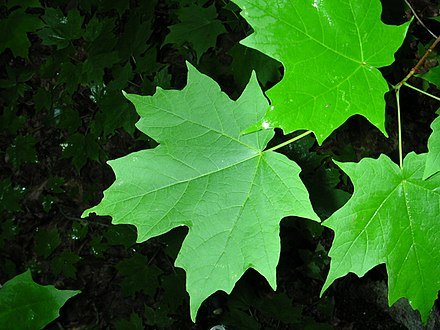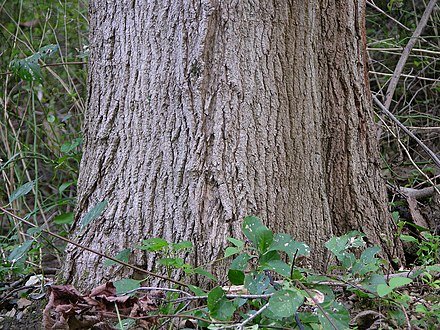
Sugar Maple
Sugar Maple
Botanical Name: Acer saccharumFamily Name: Sapindaceae – Soapberry familyOrigin: Eastern North AmericaDirectly behind Dodona Manor along the left side of the boxwood hedge is a large sugar maple tree. The sugar maple is best known for being the primary source of maple syrup and for its brightly colored fall foliage. Sugar maples typically grow 60 to 75 feet tall and spread 40 to 50 feet at maturity. The tree is long-lived, typically 200 years and occasionally as much as 300.
In the fall the color of the sugar maple is often spectacular, ranging from bright yellow on some trees through orange to fluorescent red-orange on others. Sugar maples also tend to color unevenly in fall. The leaf buds are pointy and brown-colored. The recent year's growth twigs are green and turn dark brown.
Although many people think a red sugar maple leaf is featured on the flag of Canada, the official maple leaf does not belong to a particular maple species. The maple leaf on the Canadian flag does most closely resemble a sugar maple leaf. The leaf on the flag was specially designed to be as identifiable as possible on a flag waving in the wind without regard to whether it resembled a particular species' foliage.
The sugar maple can be confused with the Norway Maple, which is not native to America but is commonly planted in cities and suburbs. Sugar maples and Norway maples are not closely related within the genus. The sugar maple is most easily identified by clear sap in the leaf petiole whereas the Norway maple has white sap.
The sugar maple is an extremely important species to the ecology of many forests in the northern United States and Canada. Pure stands are common, and it is a major component of the Northern and Midwestern U.S. hardwood forests. Due to its need for cold winters, sugar maple is mostly found north of the 42nd parallel in USDA growing zones 3–5. It is less common in the southern part of its range (USDA Zone 6) where summers are hot and humid. In the east, from Maryland southward, it is limited to the Appalachians. In the west, Tennessee represents the southern limit of its range, and Missouri its southwestern limit. Collection of sap for sugar is also not possible in the southern part of sugar maple's range as winter temperatures do not become cold enough.
Sugar maple is among the most shade tolerant of large deciduous trees. Like other maples, its shade tolerance is manifested in its ability to germinate and persist under a closed canopy as an understory plant and respond with rapid growth to the increased light formed by a gap in the canopy. Sugar maple can tolerate virtually any soil type short of pure sand but does not tolerate dry and low humidity or swampy conditions.
Sugar maples are deeper-rooted than most maples and engage in hydraulic lift, drawing water from lower soil layers and exuding that water into upper, drier soil layers. This not only benefits the tree itself, but also many other plants growing around it.
Human influences have contributed to the decline of the sugar maple in many regions. Its role as a species of mature forests has led it to be replaced by more opportunistic species in areas where forests are cut over. The sugar maple also exhibits a greater susceptibility to pollution than other species of maple. Acid rain and soil acidification are some of the primary contributing factors to maple decline. Also, the increased use of salt over the last several decades on streets and roads for de-icing purposes has decimated the sugar maple's role as a street tree.
In some parts of New England, particularly near urbanized areas, the sugar maple is being displaced by the Norway maple. The Norway maple is also highly shade tolerant, but is considerably more tolerant of urban conditions, resulting in the sugar maple's replacement in those areas. In addition, Norway maple produces much larger crops of seeds, allowing it to out-compete native species.
Maple Syrup and Other Food Use
The sugar maple is one of the most important Canadian trees along with the black maple, the major source of sap for making maple syrup. Other maple species can be used as a sap source for maple syrup, but some have lower sugar content and/or produce more cloudy syrup than these two. In maple syrup production from sugar maples, the sap is extracted from the trees using a tap placed into a hole drilled through the phloem, just inside the bark. The collected sap is then boiled. As the sap boils, the water evaporates, and the syrup is left behind. Forty gallons of maple sap produces 1 gallon of syrup. In the southern part of their range, sugar maples produce little sap; syrup production is dependent on the tree growing in cooler climates.
The seeds can be soaked, and—with their wings removed—boiled, seasoned, and roasted to make them edible. The young leaves and inner bark can be eaten raw or cooked.
Timber
The sapwood can be white, and smaller logs may have a higher proportion of this desirable wood. Bowling alleys and bowling pins are both commonly manufactured from sugar maple. Trees with wavy wood grain, which can occur in curly, quilted, and “birdseye maple” forms, are especially valued. Maple is also the wood used for basketball courts, including the floors used by the NBA, and it is a popular wood for baseball bats, along with white ash. In recent years, because white ash has become threatened by the emerald ash borer, sugar maple wood has increasingly displaced white ash for baseball bat production. It is also widely used in the manufacture of musical instruments, such as the members of the violin family (sides and back), guitars (neck), grand pianos (rim), and drum shells. It is also often used in the manufacture of sporting goods.
Canadian maple, often referred to as "Canadian hardrock maple", is prized for pool cues, especially the shafts. Some production-line cues will use lower-quality maple wood with cosmetic issues, such as "sugar marks", which are most often light brown discolorations caused by sap in the wood. The best shaft wood has a very consistent grain, with no marks or discoloration. Sugar marks usually do not affect how the cue plays but are not as high quality as those without it. The wood is also used in skateboards, gunstocks, and flooring for its strength.

